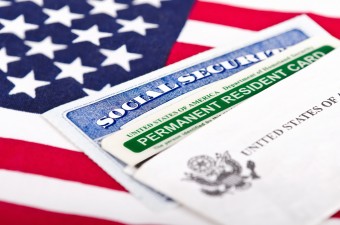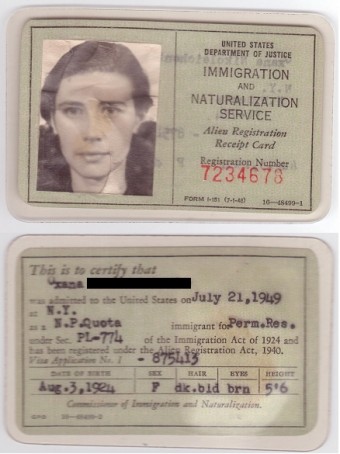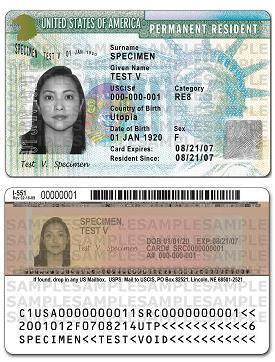Why are Green Cards Called That?
 A Permanent Resident Card from the United States government allows immigrants to legally work, live, and study inside the country. Despite the name “Permanent Resident Card”, it expires after ten years. But those legal residents may apply for citizenship after five years. It is more commonly known by its shorter name, the “green card.” But how did it come to be called this? The answer lies in the history of immigrant registration in the United States and attempting to keep one step ahead of counterfeiters.
A Permanent Resident Card from the United States government allows immigrants to legally work, live, and study inside the country. Despite the name “Permanent Resident Card”, it expires after ten years. But those legal residents may apply for citizenship after five years. It is more commonly known by its shorter name, the “green card.” But how did it come to be called this? The answer lies in the history of immigrant registration in the United States and attempting to keep one step ahead of counterfeiters.
The Alien Registration Act of 1940 marked the first time that the United States government required all immigrants to be registered, allowing the government to know exactly who had immigrated to the country. Section 31 (a) of Title II specifically addressed the issue for immigrants who were not already documented when they entered the country.
It shall be the duty of every alien now or hereafter in the United States, who (1) is fourteen years of age or older, (2) has not been registered and fingerprinted under section 30, and (3) remains in the United States for thirty days or longer, to apply for registration and to be fingerprinted before the expiration of such thirty days. Whenever any alien attains his fourteenth birthday in the United States he shall, within thirty days thereafter, apply in person for registration and to be fingerprinted.
Immigrants filled out forms at their local post office, and that paperwork made its way to the federal government. The Immigration and Naturalization Services (INS) processed the forms before sending a receipt card to each immigrant. That card, known as the AR-3 form, was a white receipt that allowed immigrants to prove to the police, government, or anyone else that they had registered their immigrant status.
 That process worked for a while, but the surge of immigrants searching for the American Dream after World War II caused a change in the system. It no longer made sense to have immigrants register at the post office. Instead, they registered and received the new Form I-151 at their port of entry into the country. This Form I-151, also known as the Alien Registration Receipt Card, was made out of a special pale green paper. As such, the card began being referred to simply as the “green card”.
That process worked for a while, but the surge of immigrants searching for the American Dream after World War II caused a change in the system. It no longer made sense to have immigrants register at the post office. Instead, they registered and received the new Form I-151 at their port of entry into the country. This Form I-151, also known as the Alien Registration Receipt Card, was made out of a special pale green paper. As such, the card began being referred to simply as the “green card”.
But the green card did not stay green for long. Counterfeit green cards became a major problem in the United States, especially after the passage of the Internal Security Act of 1950. At this point, legal immigrants to the United States could exchange their AR-3 form for a Form I-151 and thus be legal permanent residents in the country. However, those without legal status could not make such and exchange. Essentially, the Alien Registration Act of 1940 did not distinguish between legal and illegal immigrants but the new green card did. Since immigrants were subject to deportation if they could not prove their legal status in the country, possessing a green card provided significant security. That naturally meant counterfeit green cards became a major problem for the INS.
As such, between the years 1952 and 1977, the green card underwent seventeen changes as the INS worked to stay one step ahead of counterfeiters. The Form I-151 became the Form I-551, the Resident Alien Card, in 1977. This version of the green card was the first not to be made of paper and the INS only allowed a single facility in Texas to produce the Resident Alien Cards in the name of making them perfectly uniform. It was also the first to have the immigrant’s fingerprint and signature on the card, along with no expiration date.
The INS changed the green card again in 1989 in response to complaints from immigrants’ employers. Employers argued that checking the validity of an immigrant’s resident status was difficult due to the numerous versions of the green card. So in 1989, the INS adopted a peach-colored Form I-551. Another change happened in 1997 when the INS again tried to stay ahead of counterfeiters by adding a unique document number to the card, which was now rebranded a “Permanent Resident Card”. In 2004, the Department of Homeland Security seal and a hologram were also added to the front of the card.
 Coming full circle, while the name “green card” stuck around even though cards hadn’t been green for many decades, the new version of the Permanent Resident Card released in May of 2010 returned to the green color. These new cards released by the U.S. Citizenship and Immigration Services contain the latest, high-tech attempts to thwart counterfeiters. Security technologies include laser-engraved fingerprints, holographic images, and embedded data.
Coming full circle, while the name “green card” stuck around even though cards hadn’t been green for many decades, the new version of the Permanent Resident Card released in May of 2010 returned to the green color. These new cards released by the U.S. Citizenship and Immigration Services contain the latest, high-tech attempts to thwart counterfeiters. Security technologies include laser-engraved fingerprints, holographic images, and embedded data.
If you liked this article, you might also enjoy our new popular podcast, The BrainFood Show (iTunes, Spotify, Google Play Music, Feed), as well as:
- Why is it Called Area 51? Where are the Other 50 Areas?
- Why Are Continental Breakfasts Called That?
- Who Was Sadie Hawkins and Why Does She Have a Dance Named After Her?
- How the Milky Way Got Its Name and What It’s Called in Other Languages
- Why Buffalo Wings Are Called That
Bonus Fact:
- One increasingly popular, though somewhat controversial, method for immigrants to qualify for a green card is called the EB-5 program. This program allows immigrants to invest $1 million in a U.S. project or program that will create at least 10 jobs in the country (not counting potential jobs created for the immigrants or their immediate families). Variations of the program allow foreigners to invest a lesser amount of $500,000 if the project meets certain criteria, such as creating those jobs in areas with high unemployment rates. Of course, the controversy here lies in this system favoring the rich.
- Green card marriages blur lines between love and convenience
- How to Get a U.S. Green Card: 10 Things to Know
- Foreign citizens making big investments in U.S. in exchange for green cards
- Visa Sale Program Helps Investors Get Green Cards, Philly Projects a Green Light
- Green Card Processes & Procedures
- Green Card Process
- To get green cards, these immigrants must prove they are extraordinary
- Just The Facts: Some Key Facts about Permanent Resident (“Green Card”) Status under Current U.S. Legal Immigration System
- History Made! First Same-Sex Spouse Granted Green Card
- The Color of the New Green Card Is Now Really Green
- New Design: The Green Card Goes Green
- Why Isn’t My Green Card Green?
- Green Card Background
- History of the Green Card
- Alien Registration Act of 1940
| Share the Knowledge! |
|





Of course, all of this doesn’t matter in the least to democrats…..open the borders and flood the nation is their agenda.